My husband and I traveled to Santorini, the gem of the Aegean Islands, and one of my must-dos was to find the best wine tasting in Santorini. Officially named Thira, Santorini is in the southern part of the Aegean Sea, about 160 miles from Athens. Known for its rich culture, beautiful turquoise waters, rugged cliffs with iconic whitewashed houses, and a beautiful volcanic landscape with stunning views, it is often on a traveler’s bucket list and I couldn’t wait to visit. What I didn’t know prior to visiting was how well-established it is as a wine-making region, and how much I would like their unique wines.
When I was looking for the best wineries in Santorini, I focused on wineries that offered different varieties, great value, and a solid tour guide. I have been on many winery tours in the past, from California to Washington to Portugal to Italy, and I wanted to know what is unique about the vineyards of Santorini. I found that and more (think views, art, and unique winemaking methods!) in Santorini. Which Santorini winery came out on top? Read on!
An Island Rich in History
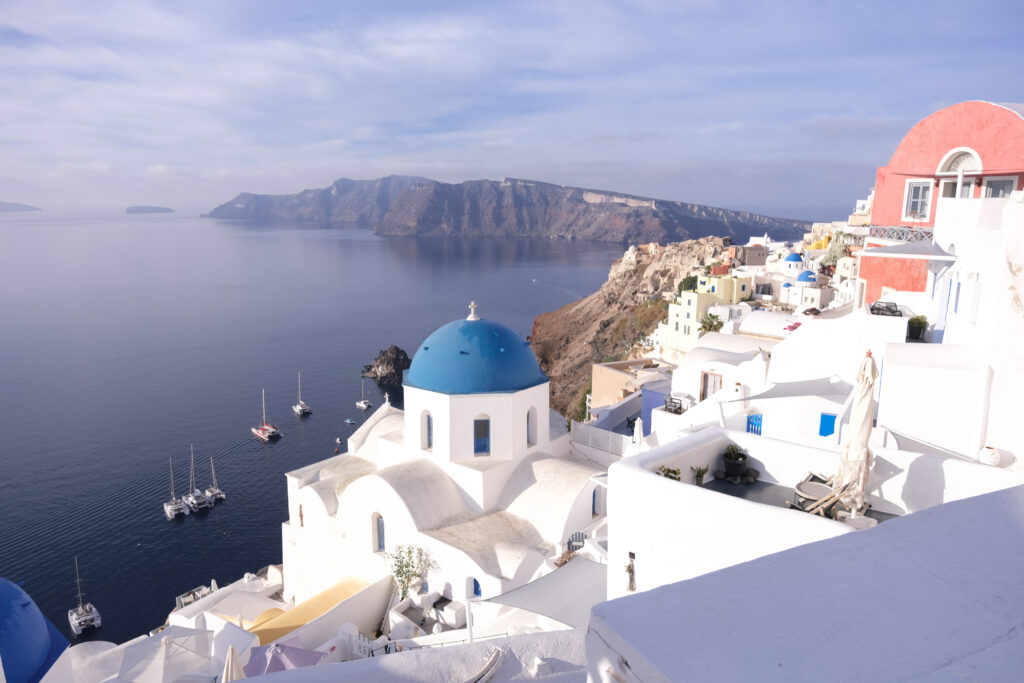
Santorini is one of the oldest wine regions in the world and a maker of great Greek wine. The island was able to escape the grape phylloxera that decimated much of Europe’s vineyards in the 19th century, making its history longer than many regions. The reason the island avoided this insect infestation was actually thanks to the poor, clay-like volcanic composition of the soil, which is inhospitable to the bugs. It was the site of a violent volcanic eruption – one of the worst in recorded history – about 3600 years ago. The result from all that volcanic ash is soil that is dry and acidic, composed of basalt, granite, pumice and obsidian, and which gives the wines of Santorini a distinct mineral taste that even a novice wine drinker can detect.
Wine-making is one of the primary agricultural practices of the island; viticulture has been a practice on Santorini for at least 3500 years, home to some of the oldest vineyards in the world. Sustainable winemaking practices are a common theme on the island, preserving the land in its pure form, as well as maintaining its biodiversity. I loved to learn that most wineries still make their wines without irrigation, utilizing a unique basket shape in the vines to aid in natural irrigation.
Along with holding a special place in its history and culture, wine production in Santorini is integral to its economy. Locals and visitors to the island alike celebrate their rich, high quality wines abundant with exceptional flavors, and many of the wines have become world renowned.
Each year, about 3,000 tons of grapes are harvested from Santorini’s vineyards. The island produces about two million bottles of wine annually, with 70 percent of it being exported outside of Greece.
Unique Weather Inspires Creative Growing
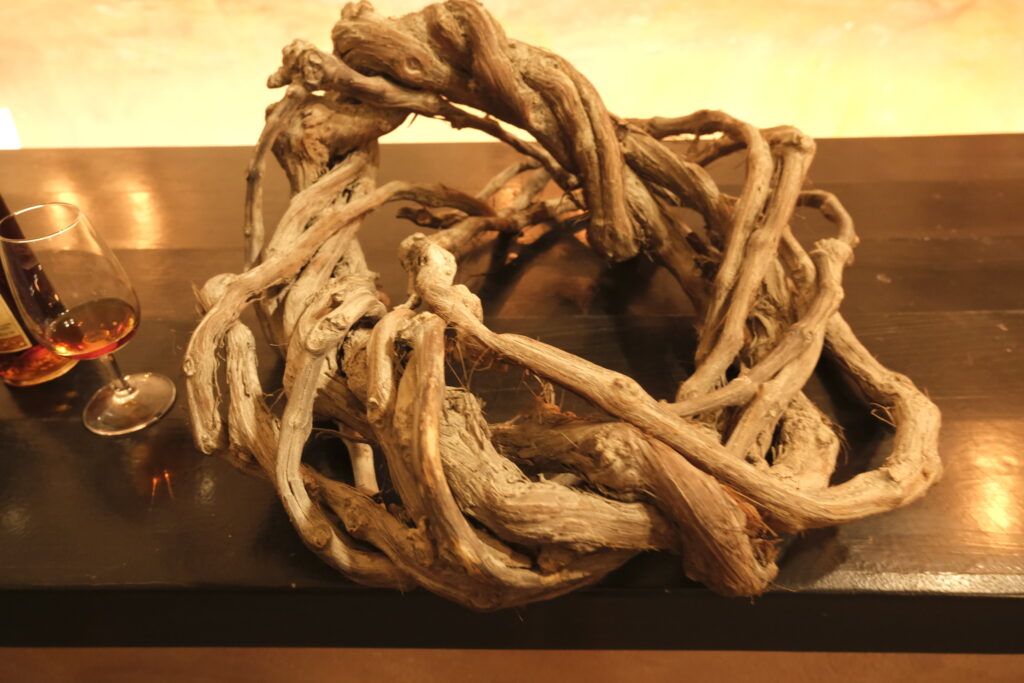
Santorini’s desert-like climate consists of strong winds, extreme sun, and very little rain. Many of the vineyards are full of vines shaped like baskets, allowing the grapes to grow inside, Santorini’s traditional method of protecting them from the elements. This growing method adds another element of beauty and uniqueness to the island’s landscape and winemaking history. And, the challenging weather patterns actually work in their favor, as the sun, soil, and humidity from the sea air keeps the vines free of pests and other diseases, and allow for natural irrigation methods from the sea mist and the air’s humidity.
The island’s unique volcanic soil and traditional vineyard practices that complement the challenging weather patterns are what make the varieties of wines so distinct and special.
Indigenous Grapes of Santorini
There are twenty-five grapes native to the island. However, five grape varieties are used in the majority of the wines. Receiving less water than other growing regions, Santorini’s grapes have an increased concentration in flavor, working in their benefit to allow for richer, fine wines.
White Grape Varieties
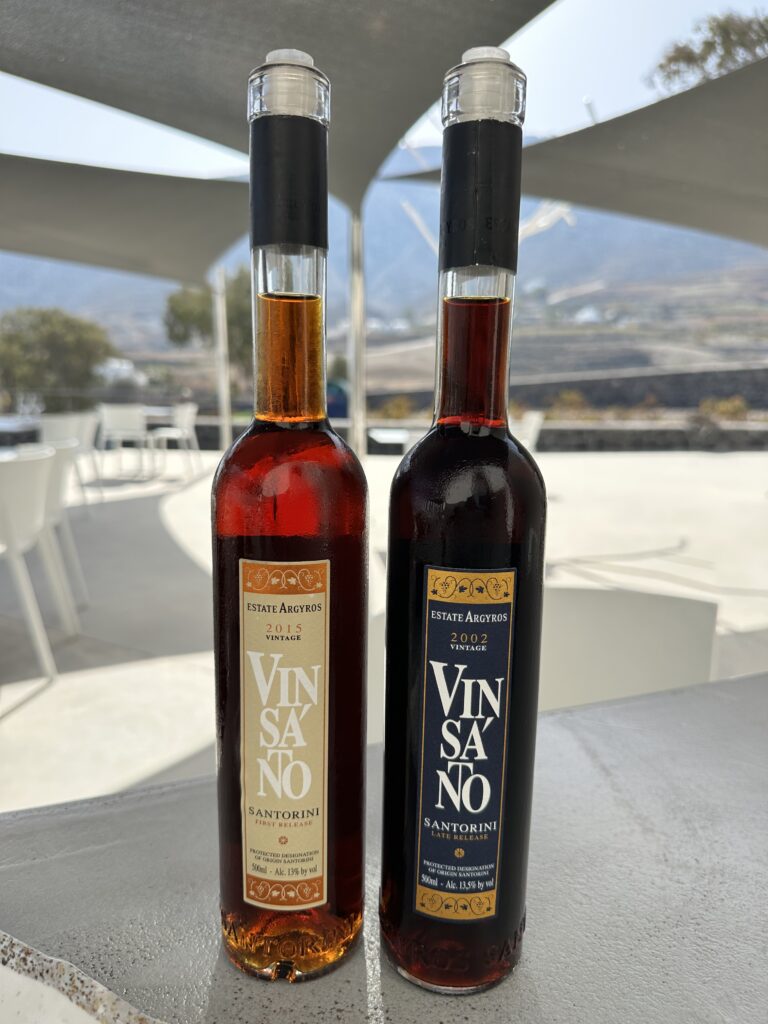
Santorini is best known for its crisp, dry white wines, as well as its famous sweet wine, Vinsanto. The combination of elements in the island’s earth results in refreshing white wines that are uniquely flavored with a light acidity and a special mineral taste.
I learned that three grapes dominate the white-wine industry of the island: Assyrtiko, Aidani and Athiri. The Assyrtiko grape is one of the world’s oldest white grapes, dating back to the 16th century. It is Santorini’s exclusive and most common indigenous grape, making up about 75% of the island’s wine production. This exceptionally flavorful grape has made a name for itself worldwide; known as the island’s ‘ambassador grape’, or the Greek Grape, it is a bold, acidic variety, with a hint of salinity, along with earthy and fruity tones.
Aidani is a dry varietal, mainly used as a blending grape with Athiri and Assyrtiko for making the island’s famous sweet amber-colored wine, Vinsanto. This late harvest wine, known as wine of the kings in the Middle Ages, is one of the best dessert wines in the world. This wine uses sun-dried grapes, left there for up to fourteen days to produce this popular sweet wine that is exclusive to Santorini. It is then aged in oak for about two years, and the result is a harmony of sweet and rich flavors, containing notes of plums, caramel, hazelnuts, and tropical fruits.
Athiri is also used as a blending grape with Aidani and Assyrtiko to make white wine varieties. It contains notes of lemon and other fruits. Athiri is an accessible wine that pairs well with mezze, small Greek plates served before the main course.
Red Varieties
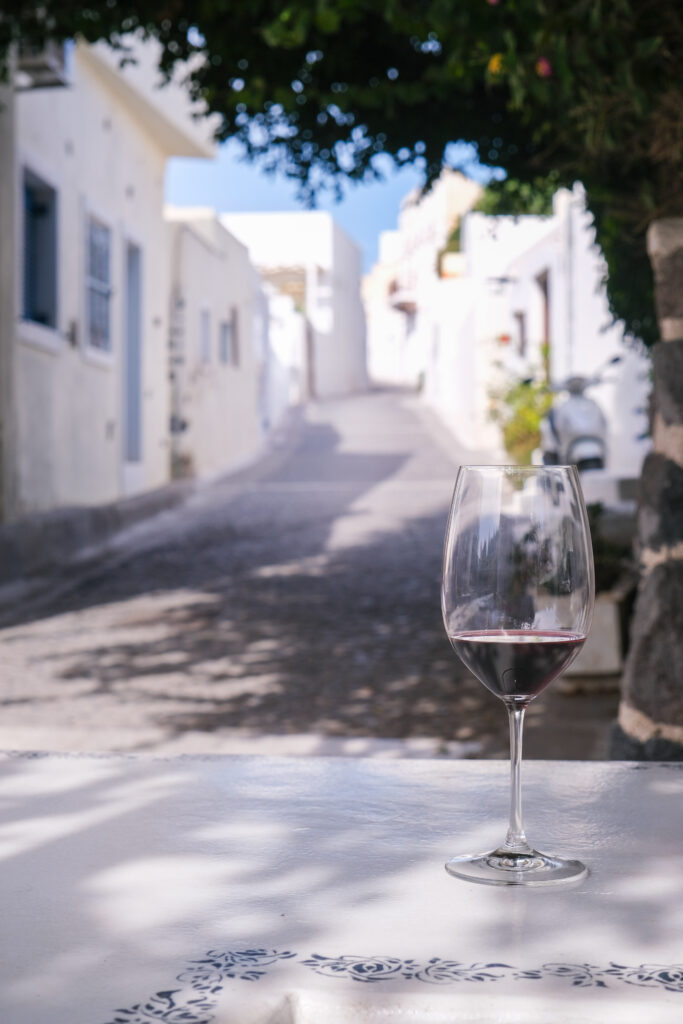
I found a bold, distinct red wine harder to come by in Santorini. But if you read on, there are a couple of fantastic wineries that produce a delicious red. Red wines of Santorini are typically deep crimson in color, and contain fruit-forward flavors of wild berries, minerals and spices.
Santorini’s red wines are predominantly produced out of the Mavrotragano and Mandilaria grapes. Mavrotragano is a red variety that is exclusive to Santorini, and makes up about two percent of the island’s grapes. These small berries, which are protected due to their threat of extinction, produce dry wines that pair well with red meats or mild cheeses. I found the Mavrotragano to be somewhat similar to a pinot noir, a lighter but very adaptable red that I ended up liking very much.
Mandilaria, a tart red variety, is the island’s second most common grape, and is made into either dry wines or blended with other varieties to produce sweet wines. Though they say it is common, I actually found Mavrotragano to be more easy to come by on Santorini.
My Favorite Santorini Wineries
The wineries in Santorini are full of history, often celebrating generations of family heritage, and you can feel the essence of passion, hard work and family bonds that grew within the vineyards.
I will take you through my experience of some of the best Santorini wineries, what they have to offer in terms of the varieties of wine, as well as other highlights that put them at the top of the list.
Best Wine Tasting Experience: Vedema

The wine tasting experience at Vedema Resort was definitely at the top of my list. Located in the medieval village of Magalachori and overlooking beautiful vineyards and the Aegean Sea, the owners have built a five-star resort into what once was a 400-year old wine cellar.
We had our tastings in the restaurant Alati, which was built into a wine cave. The enchanting, stonewalled candlelit space made us feel like royalty from the Middle Ages, and while wine tasting, we enjoyed beautiful views of the village of Magalahori. Hosted by the resort’s Food and Beverage Director, she was extremely knowledgeable, and the wines we tasted were amazing. We enjoyed a private tasting with a delicious food pairing. Vedema kindly gifted us our tasting.
Vedema Wine Varieties
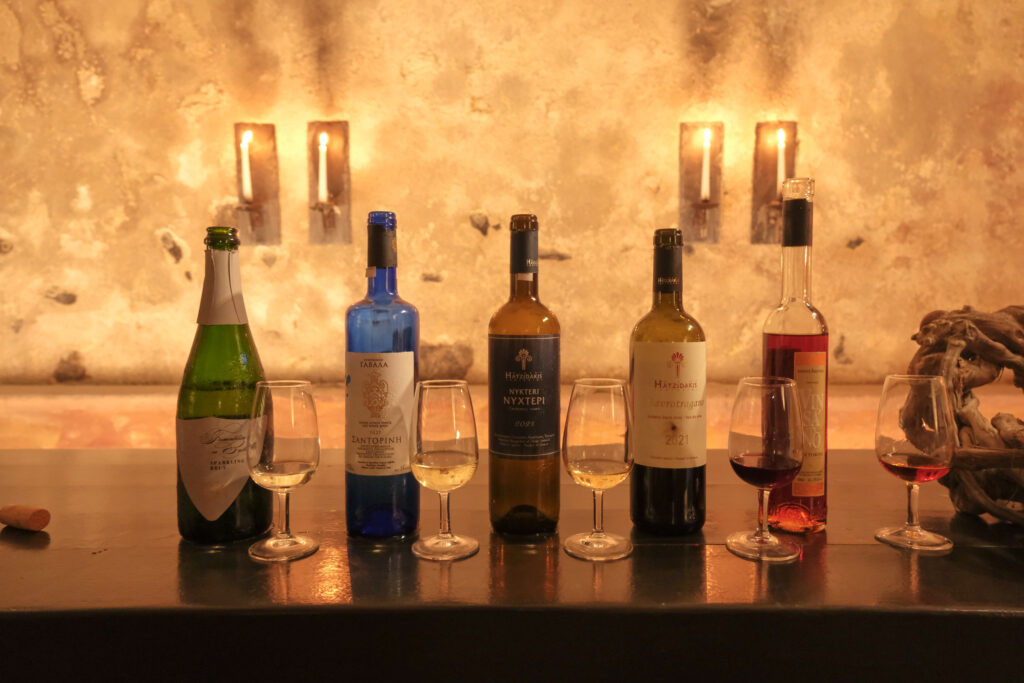
What I loved most about my tasting at Vedema was the variety of wines that we were able to try, including the only sparkling wine made in Santorini and the only local sparkling I could find anywhere. Because Vedema doesn’t make its own wines, we got a very curated, high quality selection of the best wines from the different Santorini wineries, including Hatzidakis Winery (Nyxteri and Mavrotragano), Santo Wines (sparkling Assyrtiko), Galavas Winery (Assyrtiko), and Estate Argyros (Vinsanto).
At Vedema, I tasted a 100% Assyrtiko wine, which is fermented in stainless steel vats for six to ten months. This doesn’t sound like a long time for a great wine, but for this wine, newer is actually better. It is an early harvest wine, which cannot age more than five years. The Assyrtiko’s prominent flavors are citrus, jasmine and white peach.
Nyxteri wine was another variety I tried here. Nyxteri wine is also Assyrtiko, but it is collected and pressed at night to prevent fermentation from the heat. It is picked on the last night of harvest, and stored in oak for one year. This wine can be aged for up to sixteen years.
I was surprised at how different Assyrtiko could taste when processed differently. The Nyxteri was more mellow and fuller-bodied than the traditional Assyrtiko.
If this wine cave experience was something you really enjoyed and want more of, be sure to also check out Hadzidakis Winery, where you can sit at the monastery benches and tables in the tasting room, located in a cave located under the vineyards! Haridimos Hatzidakis, who passed away in 2017, was highly regarded as a winemaker responsible for putting Greek wines on the map. He was known for producing exceptional wines that were reflective of Santorini’s terroirs.
The owners today focus their winemaking on the Aidani variety, and have an amazing Vinsanto wine, aged more than fourteen years.
Best Guided Tour: Estate Argyros Winery

Estate Argyros, just outside of Pyrgos, was another favorite winery of mine. The Argyros family is the largest private vineyard owner in Santorini. Currently run by fourth generation Matthew Argyros, the winery was established in 1903, but wine production began decades before that. In the 18th century, some of the family’s wines were exported to Egypt and Russia.
With a vineyard that stretches across 120 hectares, the estate focuses on the wines made by the Assyrtiko grape, and they produce some amazing whites and rose wines from it. The prominent aromas in their white wines are salt, minerals, tropical fruit and honey. This well-established winery, which has been listed as one of the Top 100 Wineries in the world for years, is home to vines that are up to 200 years old!
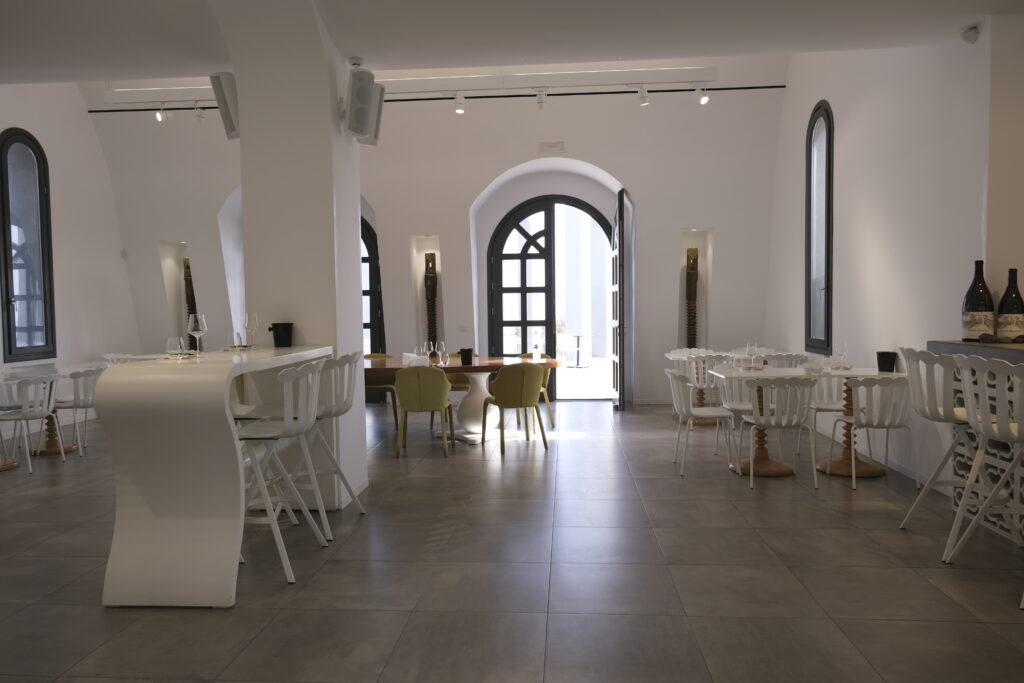
Argyros has both an indoor tasting room with a long wine bar, as well as a huge covered patio overlooking the vines. The patio was a great spot for a private wine tour. Our guide was friendly, informative, and even gave us a tour of the facilities and vineyards.
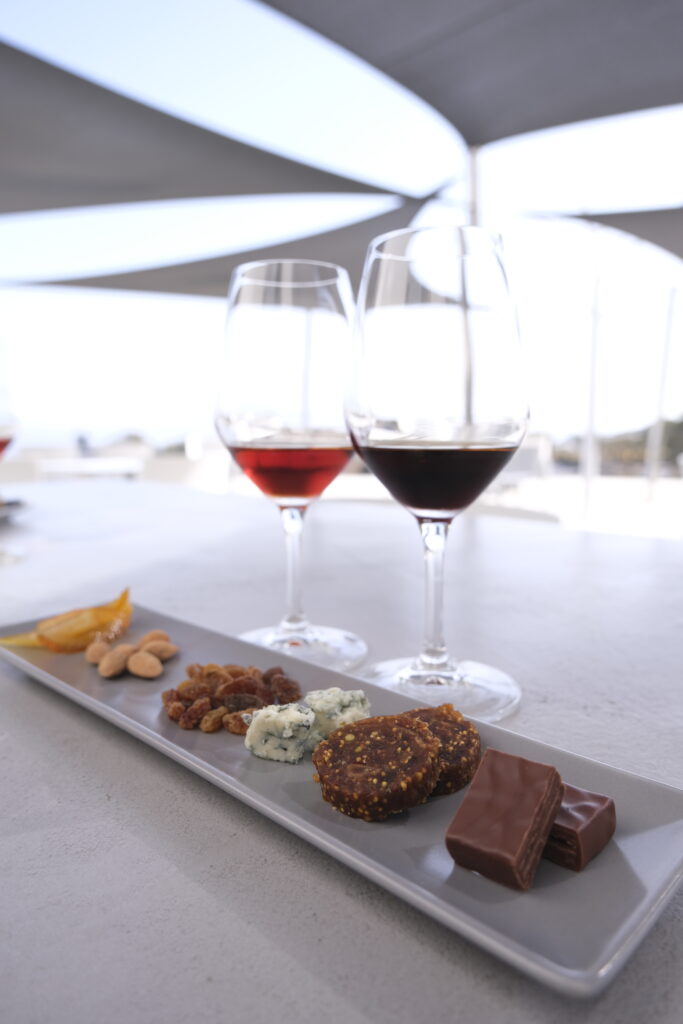
On our gifted tasting, we enjoyed several unique local wines, including an Assyrtiko (also called a Santorini wine), a white blend, and a vertical tasting of 2 years of the vinsanto dessert wine. The wines were expertly paired with snacks like meats, cheeses, and dessert offerings like candied orange peels, chocolate covered nuts, and dried fruits.
Argyros: A Great Place for Seeing Unique Traditional Growing and Harvest Methods
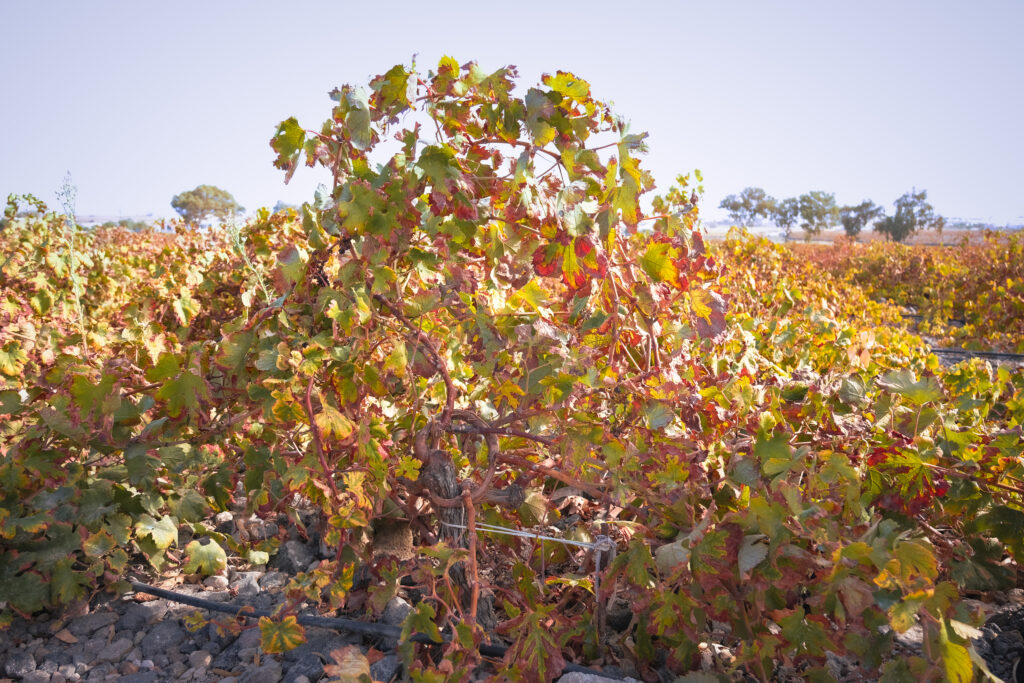
Santorini’s growing methods are so unique, and this winery is the perfect place to introduce yourself to the winemaking practices in Santorini. I loved Argyros Winery partly because of the guided tour, where you get to see Santorini’s method for growing the vines in the shape of baskets, called Kouloura, up close.
These baskets are handmade, bending the wood from the vines themselves into a circular shape. The basket’s shape traps the humidity, providing natural irrigation to the vines, and protects them from the intense heat and strong winds that can cause sandstorms. The indigenous semi-porous pumice rocks laid underneath the baskets also play a vital role, as they absorb moisture from the ground and sea mists, which means that the taller vines can also survive without irrigation.
In areas that are not exposed to the extreme winds, a pruning method called Koulouri, in which a small trellis with loops is perpendicular to the ground, yields fewer but high-quality grapes. The majority of their grapes are now grown using this low bush system, which allows for better airflow and greater control of shade and vegetation compared to the traditional basket method.
Harvesting the grapes usually occurs in the middle of August and lasts about one month. The process is still done by hand, and without any pesticides. Once picked, the grapes are refrigerated for fourteen hours, to prevent any biological problems from developing. There are strict standards for which grapes are used in the winemaking process; each grape that is harvested is closely evaluated, and any substandard grapes are removed. The pressed elements are then composted back into the vineyards.

Despite the large size of Argyros Winery, production is fairly low, as the winemakers are more interested in producing the best possible flavors and allowing the vines to mature on their own time. The varying times of harvest allow the winery to produce a wide range of white wines from the Assyrtiko grape, as well as wines from the indigenous Aidani and Mavrotragano grapes. They have some amazing Assyrtiko wines that you must try, as well as their Vinsanto dessert wine. Vinsanto is produced from grapes that are dried out over an extended period of time to increase their sugar concentration. Try their signature 20 year old Vinsanto that can be savored- it will keep for up to six months if opened, and up to 100 years if unopened.
We bought a bottle of the 2020 Cuvee Monsignori Santorini wine to enjoy at our hotel, along with a 2002 vinsanto. We never saw either of these bottles at the various restaurants and grocery stores, which made it extra special that we could get them directly from the winery.
Best Winery for Stunning Sea and Caldera Views: Santo Winery

If you would like to enjoy one of the best views of Santorini while sipping on some of the finest wines the island has to offer, I would definitely put Santo Wines at the top of your list. Santo Wines, founded in 1911, is the largest winery on the island. It is built right into the cliffside between the villages of Fira and Pyrgos, and boasts stunning views of the caldera and Mediterranean Sea. It consists of a winery, wine tourism center, and tomato processing plant. This beautiful modern winery has become one of the top destinations for wine tourism, with over 600,000 visitors each year from across the globe, and I can totally understand why.
You can choose from a number of different wine-tasting experiences, where a wine specialist will guide your senses through the aromas, tastes and varieties of the wines. The winery produces an amazing vinsanto wine, so be sure to add that to your tasting. You will also find a delicious deli inside the winery, so it’s a great opportunity to try some fresh local produce.
This would be the perfect place for sipping a glass of wine while taking in the most stunning caldera views; I recommend timing your visit to catch the sunset on their amazing glass-walled patio for an unforgettable evening.
Best Winery for Unique Souvenir Wine: Gaia Wines

For a laid back, beachfront winery experience with stunning sea views, head to Gaia Winery, located on Avis Beach on the eastern side of the island. Founded in 2004 by two friends, they transformed a unique stone building used as a tomato factory in the early 20th century into the winery it is today. The winery’s 70-80 year old vineyards largely contain Assyrtiko grapes. The owners of Gaia also have vineyards in Nemea, a village outside of Athens, where they grow a varietal called Agiorgitiko. This red grape produces fresh, light-bodied red wines and fruity roses.
We learned that Gaia Wines is one of the very few producers of submerged wine in the world. The winery submerges about 500 bottles annually, where ideal conditions 20 meters below the surface allow the wine to age perfectly over four years, absent from any heat, light or oxygen. The result is a wine called Thalassitis, a dry, full-bodied, acidic wine, with a hint of minerals and a honeysuckle. This bottle will cost you about $300, but for wine lovers, indulging in such a rare bottle from the source could be a once in a lifetime experience!
You may be wondering, why age wine underwater? Submerged wines can develop a number of unique characteristics, due to the features of its environment, including natural temperature regulation, high pressure, absence of light rays, and the movement and energy of the sea. These features produce unique flavors which wouldn’t otherwise be possible.
The grapes for this rare wine are harvested in small yields, and come from 80-year old vines. It is typically enjoyed with food pairings such as seafood or lamb. In addition to its wines, Gaia Wines produces a rare, sweet Assyrtiko vinegar, that is made in conjunction with the submerged wine, and aged for five years.
Best Winery for the Art Enthusiast: Art Space Winery

I am a self-professed art dunce, but the Art Space Winery is definitely worth seeing even if you fail to appreciate art like I do. It originated from a winery built in 1861. Before that, it was a processing center for the island’s famed tomatoes. There are three main areas: an underground cave with an art exhibit displaying sculptures and contemporary paintings from Greek and international artists, a museum showcasing artifacts from the original winery, and modern tasting room and winery.
Wine is matured in cellars that are 12 meters underground, surrounded by a thick layer of pumice rock.There are two advantages to this underground winery space. First, the pumice layer acts as a great insulator for the wine, allowing for greater aging. Second, the difference in altitude allows for vertical vinification, letting gravity do the work for natural flow, instead of using pumps and other industrial equipment..
The majority of wines at Art Space are whites from the Assyrtiko varietal. They also have a well-rounded Vinsanto blend with Assyrtiko, Aidani, and Athiri.
In general, I found the experience and ambience of Art Space to be quirky, approachable, and offbeat. I personally didn’t love the wines as much as those I tried at other locations, but it is still worth a stop for a sip and a one-of-a-kind souvenir.
Best Food Pairings- Mystique Resort
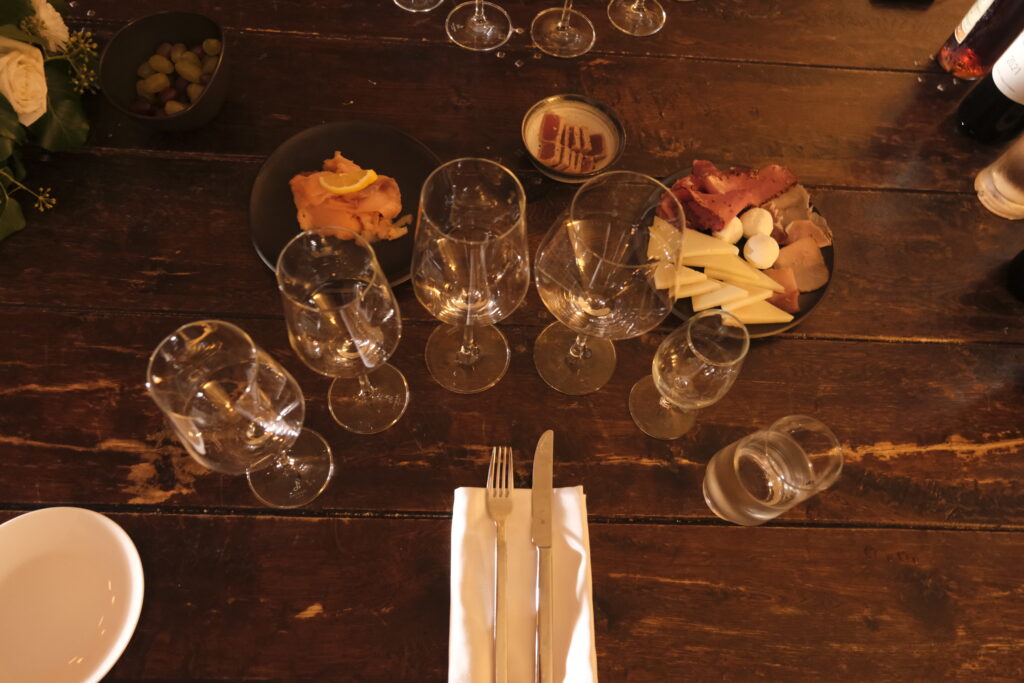
There’s something pretty special about doing a wine tasting in a secret underground cave…and I was lucky enough to do it at two different resorts on Santorini. The first was Vedema, and the second was its sister property in Oia, Mystique.
Though overall I liked Mystique much better as a resort, the tasting at Vedema was better than that at Mystique. Perhaps it was because it wasn’t the first tasting/tour of its kind that we attended, so the information and background on Santorini’s vineyards during the presentation of wines just wasn’t as interesting. The wine tasting itself was also much more expensive than your average tasting experience in the US, at about $70 USD per person.

The ambience of the wine tasting room was very neat, and thus still allowed for a great experience. Set in a 150 year old wine cellar, it is a unique space that makes you feel like you are back in ancient times. Also, the food pairings were meal-size portions in comparison to the average fruit and cheese pairings that you would normally receive with a tasting. So if it is around lunchtime and you have an appetite, this would be a great winery to visit!
Other Notable Wineries of Santorini
Best Combination of Tradition and Modern Practices – Venetsantos Winery
The Venetsantos family has been producing wine for the island and beyond for many years. Their winery was built in 1947, and they were the first industrial winery of the island. The architecture, using a reverse-gravity method (built from the top down) is striking, and offers amazing caldera and volcano island views.
They have a well-rounded list of wines, including a 100 percent Assyrtiko, with hints of pear and citrus, red wines from the Mandilaria with hints of plum, fig, and spices, and a rose made from Assyrtiko, Aidani and Mandilaria. You can also enjoy traditional Santorini food while taking in stunning sea views.
Best For Foodies and Red Wine Lovers – Domaine Sigalas Winery
The Domaine Sigalas winery, known as one of the best wine producers in Greece, is located near the picturesque coastal town of Oia. This award-winning boutique winery has not only perfected an Assyrtiko white wine, but it also produces amazing red wines, which is hard to find on the island. The reds often have bold flavors of cinnamon and licorice, and are made from Mandilaria and Mavrotragano grapes.
The owner of the winery, Paris Sigalas, has been experimenting with growing Assyrtiko grapes in different locations of the island, using identical planting methods, and has found that each location brings out unique flavors.
Their famous Assyrtiko Santorini Barrel wine is a great summer wine, with complex notes of a mineral lemon, as well as a rugged smokiness from aging in oak barrels.
The winery has a beautiful terrace in the middle of the vineyard, and their delicious food menu has made a name for itself in Santorini.
Best Winery for Organic Farming Practices – Hadzidakis Winery
The Hadzidakis family has established the only organically certified winery in Santorini. With 100 acres of vineyards, the bulk of their grapes are Aidani. The winery itself is located in caves under the vineyards, providing an optimal environment for the wines.
Hadzidakis Winery was the first to produce wines from the native Mavrotragano red grape. Haridimos Hatzidakis, who passed away in 2017, was highly regarded as a winemaker responsible for putting Greek wines on the map. He was known for producing exceptional wines that were reflective of Santorini’s terroirs.
You can take a guided tour to learn about the grape varieties of the island, as well as the unique climate and organic farming practices. The location of the winery underneath the vineyards provides a really unique experience. Sitting at the monastery tables and wooden benches will make you feel like you are living in the Middle Ages! Be sure to try their amazing Vinsanto wine,aged more than fourteen years.
Rare Indigenous Wine Varieties – Gavalas Winery
The Gavalas Winery, outside of Pyrgos, is a family-owned, fifth generation winery located in the traditional village of Megalochori. They produce many traditional Santorini wines, including Assyrtiko, Nykteri and Vinsanto varieties. It is also the only winery to cultivate two rare, indigenous grape varieties, Katsano and Voudomato.
How to Visit Santorini Wineries
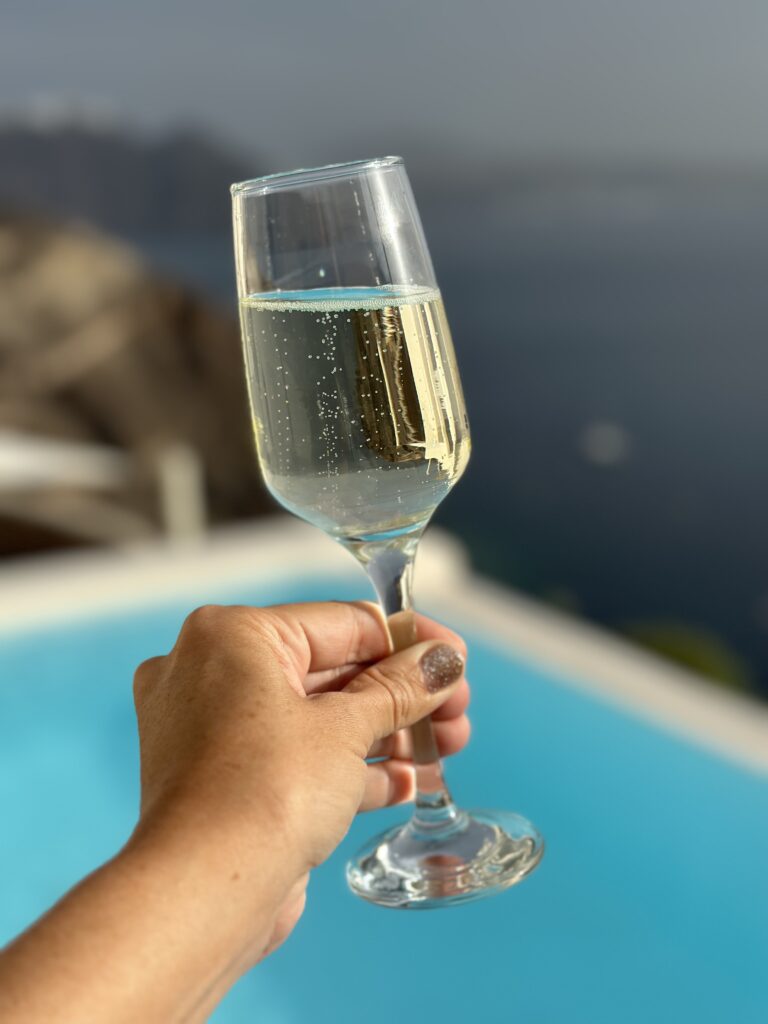
A guided wine tour is a great way to immerse yourself in the island’s unique wine culture, by trying a variety of wines, and getting to know local wine producers. Here is a shortlist of some of the best wine tours in Santorini.
Rather than go on an organized wine tasting, I hired a private driver for the day and put together my own tasting day, coordinating directly with the wineries. I worked with Omega Travel (not sponsored – I booked through Get Your Guide) and our driver was fantastic. He not only took us around to different wineries, but he suggested viewpoints for photos and gave us a wonderful tour of island, all in one 6-hour booking.
To experience the flavors of wine and cuisine, Get Your Guide also has a half-day tour available where you get to visit two traditional wineries, and then participate in a cooking class, where you will learn how to create traditional Greek dishes.
Another option is a private five hour wine tour, where you will visit three selected wineries, such as Anhydrous Winery, Gaia Wines, Gavalas Winery, Venetsantos, or others. If you have a preference on which three you would like to visit, you can request beforehand. Enjoy wine pairings while tasting, and learn about the viticulture practices of the island, as well as their indigenous grape varieties.
To really explore and get to know the island, you may want to consider a private tour of Santorini, where you get to see much of the island, get to know its history, and visit some notable areas such as the Monastery of Prophet Elias and some stunning volcanic beaches.
Wrap Up
Wine, ocean and caldera views, and beautiful ancient architecture mesh together in this amazing Greek island, providing the perfect destination for an unforgettable wine tasting experience. I was so pleasantly surprised at the quality of Santorini wines, and I recommend newbies and wine snobs alike to visit 1-2 wineries when on the island. Any more than that and you’ll get bored with the same explanations and variations of the same wines, since they really only make 5 varietals. 1-2 wineries is the perfect half-day adventure, and can be paired with stops for photos, shopping, and exploring some of the smaller towns you might not otherwise visit.







